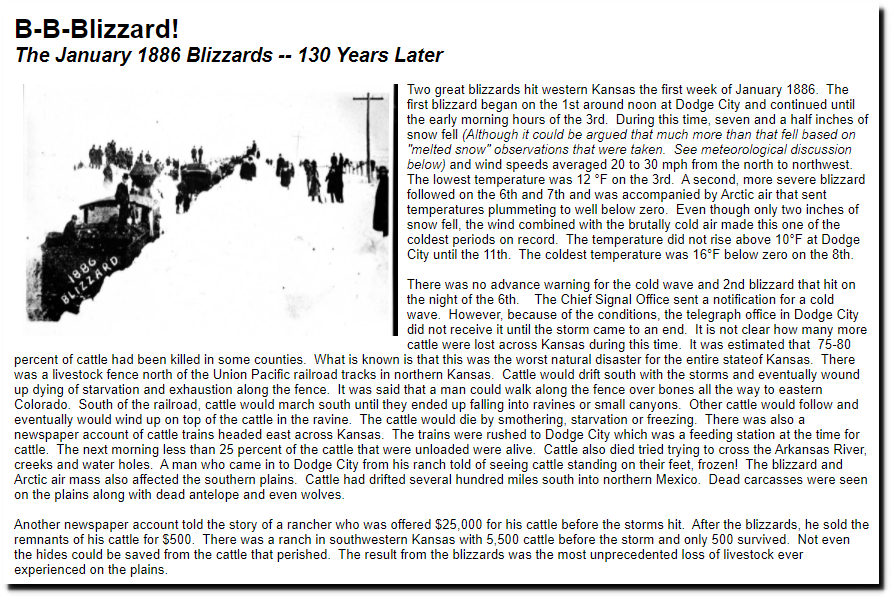“Two great blizzards hit western Kansas the first week of January 1886. The first blizzard began on the 1st around noon at Dodge City and continued until the early morning hours of the 3rd. During this time, seven and a half inches of snow fell (Although it could be argued that much more than that fell based on “melted snow” observations that were taken. See meteorological discussion below) and wind speeds averaged 20 to 30 mph from the north to northwest. The lowest temperature was 12 °F on the 3rd. A second, more severe blizzard followed on the 6th and 7th and was accompanied by Arctic air that sent temperatures plummeting to well below zero. Even though only two inches of snow fell, the wind combined with the brutally cold air made this one of the coldest periods on record. The temperature did not rise above 10°F at Dodge City until the 11th. The coldest temperature was 16°F below zero on the 8th.
There was no advance warning for the cold wave and 2nd blizzard that hit on the night of the 6th. The Chief Signal Office sent a notification for a cold wave. However, because of the conditions, the telegraph office in Dodge City did not receive it until the storm came to an end. It is not clear how many more cattle were lost across Kansas during this time. It was estimated that 75-80 percent of cattle had been killed in some counties. What is known is that this was the worst natural disaster for the entire stateof Kansas. There was a livestock fence north of the Union Pacific railroad tracks in northern Kansas. Cattle would drift south with the storms and eventually wound up dying of starvation and exhaustion along the fence. It was said that a man could walk along the fence over bones all the way to eastern Colorado. South of the railroad, cattle would march south until they ended up falling into ravines or small canyons. Other cattle would follow and eventually would wind up on top of the cattle in the ravine. The cattle would die by smothering, starvation or freezing.”
Disrupting the Borg is expensive and time consuming!
Google Search
-
Recent Posts
- “Earlier Than Usual”
- Perfect Correlation
- Elon’s Hockey Stick
- Latest Climate News
- “Climate dread is everywhere”
- “The Atmosphere Is ‘Thirstier.’”
- Skynet Becomes Self Aware
- “We Have To Vote For It So That You Can See What’s In It”
- Diversity Is Our Strength
- “even within the lifetime of our children”
- 60 Years Of Progress in London
- The Anti-Greta
- “a persistent concern”
- Deadliest US Tornado Days
- The Other Side Of The Pond
- “HEMI V8 Roars Back”
- Big Pharma Sales Tool
- Your Tax Dollars At Work
- 622 billion tons of new ice
- Fossil Fuels To Turn The UK Tropical
- 100% Tariffs On Chinese EV’s
- Fossil Fuels Cause Fungus
- Prophets Of Doom
- The Green New Deal Lives On
- Mission Accomplished!
Recent Comments
- GW on “Earlier Than Usual”
- Francis Barnett on “even within the lifetime of our children”
- conrad ziefle on “Earlier Than Usual”
- Gordon Vigurs on “Earlier Than Usual”
- Bob G on “Earlier Than Usual”
- MLH on “Earlier Than Usual”
- Gordon Vigurs on Perfect Correlation
- Jack the Insider on “Earlier Than Usual”
- Bob G on “Earlier Than Usual”
- John Francis on “Earlier Than Usual”


